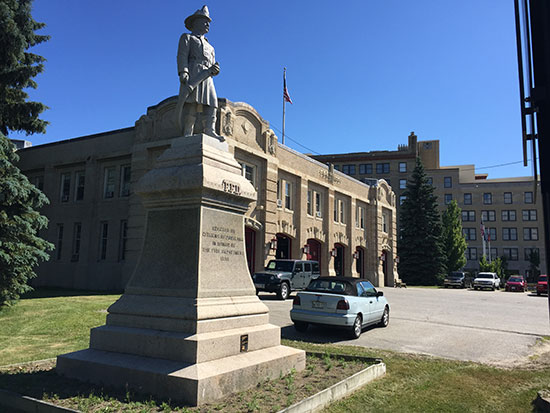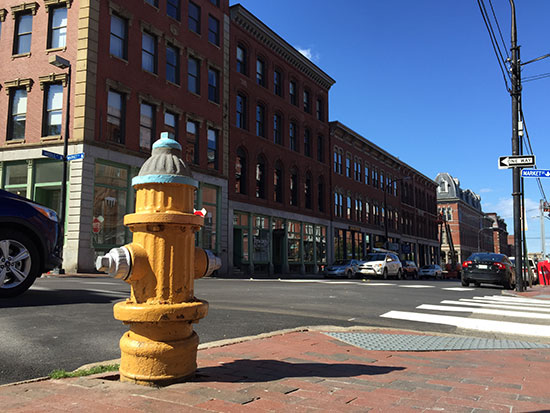Could It Happen Today?
Under the right conditions, fire can become a nearly insatiable beast.
That’s what happened in Portland on the afternoon of July 4, 1866. High winds, lack of water, plenty of fuel and other factors conspired to turn a thriving city in the midst of celebration into a roaring, relentless inferno. From a firecracker’s spark in a Commercial Street boat shop, the fire leapt from one wooden building to the next, across narrow streets and down back alleys, until it was so big and so hot that even brick buildings were consumed.
“It created a microclimate,” said Robert Solomon of the National Fire Protection Association. “Fire needs air, and when it gets that big, it starts to suck in air from the surrounding area. It becomes its own monster, to some extent.”
When the flames finally subsided the next day, one-third of the city was destroyed. About 1,500 buildings were gone, more than 10,000 people were homeless, three were dead and one was mortally injured.Property damage was estimated between $10 million and $15 million, more than $200 million in today’s dollars, with insurance covering only about $5 million.

Portland's modern, professional fire department is another reason a conflagration is unlikely to happen today. There are well over 200 full-time paid firefighters today, compared to four at the time of the Great Fire. Photo by John Richardson.
It’s unlikely that Portland would experience a similar conflagration today, fire experts say, because building construction, technology and firefighter training have improved greatly in the last 150 years. But catastrophic fires still happen, and those experts aren’t making any promises.
“We never want to say never, but the likelihood of that happening ever again is very slim,” said Assistant Chief Keith Gautreau, public information officer of the Portland Fire Department.
The Great Fire of 1866 shares many characteristics of other major urban fires of the 1800s and early 1900s, including the Great Chicago Fire of 1871, the Great Boston Fire of 1872 and the San Fransisco Earthquake & Fire of 1906.
Common contributing factors included dry and windy weather conditions, lack of water and poor distribution systems, limited firefighting equipment and techniques, and many wood-frame buildings in close proximity. While many communities tried to promote safer building standards – thatched roofs and wooden chimneys were banned in Boston in the 1600s – many early regulations were largely ignored.
“It was like the Wild West back then,” Solomon said. “By God, it’s my land and I’ll build whatever I want.”
COMMON FACTORS OF BIG FIRES
Subsequent zoning regulations and fire codes established parameters for how close and tall buildings could be and required fire resistant building techniques and materials. They also established street widths and separate districts for homes, businesses and industrial operations.
“Building codes have improved, but buildings in some neighborhoods are still close together,” Gautreau said.
The move toward a nationalized building code started in the early 1900s, Solomon said. Insurance companies compelled property owners to comply by refusing to cover buildings that didn’t meet standards.
“It often took the local leadership to take political steps to make sure a large fire didn’t happen again,” said Solomon, who manages the association’s Division of Building Fire Protection and Life Safety.
Steam engines and other upgrades in technology improved firefighting equipment, including hydrants and hoses that were the same size in every city, so fire departments could offer mutual aid to neighboring communities. The invention of the telegraph system in 1844 prompted a gradual switch from using church bells to report fires to developing actual fire alarm systems, which helped firefighters respond more quickly.

Fire hydrants, an alarm system, wider streets and brick construction are some of the reasons downtown Portland is far better protected 150 years after the Great Fire. Photo by John Richardson.
Today, Portland’s fire trucks pump 1,500 gallons of water per minute, ladder trucks can reach the ninth floor of most buildings and firefighters get to the scene of most calls within 2.5 to 4 minutes, Gautreau said. Widespread use of smoke alarms has further reduced fatalities and property damage, he said.
But while modern construction standards and building materials have resulted in fewer fires, those that do occur can burn faster, hotter and produce harmful gases that can be just as dangerous because modern furnishings often contain toxic chemicals.
“The equipment is different, the training is different and communication is different,” Solomon said. “You still put the wet stuff on the red stuff, but the understanding of and response to fire is so much more advanced.”
NEW TECHNOLOGY, OLD CONCERNS
City-consuming fires had abated by the 1920s, according to William Shields, Ph.D., a fire expert who wrote “Urban Conflagrations in the United States.”
“While large, multi-building fires continued to cause great damage on occasion, the vast infernos leveling hundreds or thousands of structures did not recur,” Shields wrote in his report.
Today, it’s wildfires, industrial accidents and even terrorist attacks such as Sept. 11 that threaten to level densely populated, urban areas with a combination of flames and other destruction.
In a 2013 rail disaster in Lac-Megantic, Quebec, near the Maine border, an unattended 74-car freight train carrying crude oil derailed and exploded in the downtown, killing 42 people and destroying 30 buildings.
And in May, a massive wildfire forced the evacuation of more than 80,000 people from Fort McMurray, Alberta, a Canadian oil-sands-producing city where 2,400 of 25,000 buildings burned, the power grid was damaged and the water was left undrinkable.
These days in Portland, “we’re more likely to have a hazardous materials incident than anything else,” Gautreau said, noting the petroleum products and other chemicals that roll through the city on local roads, highways and railroad lines.
One hundred and fifty years after one-third of Portland went up in flames, it would take a disaster of major proportions to create similar circumstances – a massive explosion or other widespread event that would break gas lines, take out electronic communications, disrupt water service to hydrants and keep firefighters from getting to affected areas.
“Is it likely that it would happen again? No,” Solomon said. “Is it possible? Sure. A catastrophic series of things would have to go wrong.”
Legacy Seared into History
150 Years Later, Death Toll Revealed
One of the disaster’s lingering mysteries is laid to rest when the Portland Press Herald/Maine Sunday Telegram examines Portland’s original death records.
MoreFire's Lasting Impact Both National and Local
The Great Fire leads to national standards for assessing fire risk, and it forges the city that survives to this day.
More
Tell your friends